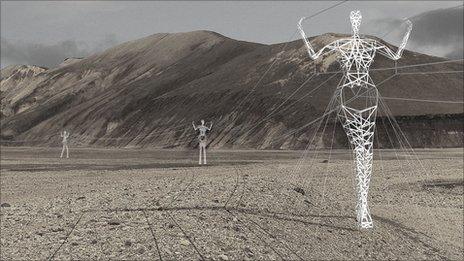Meet the 'pylon spotters'
- Published
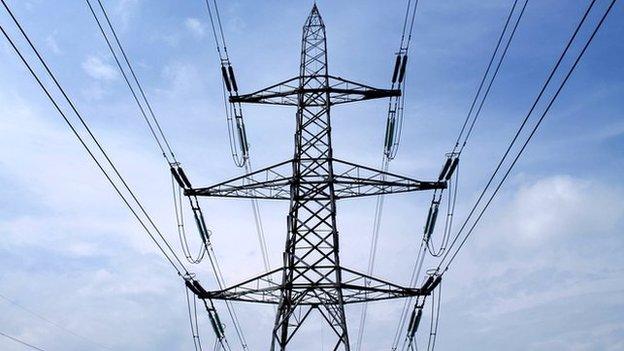
Loved and loathed, the British "lattice" pylon has been built to the same design for 90 years
Until the launch of a new design this week, British pylons have been built to the same "lattice" design for the best part of a century. You might be forgiven for thinking they were all the same. But not so, as the nation's "pylon spotters" attest.
To some they are a blot on the landscape; to others they have a kind of skeletal beauty.
Whatever your personal opinion, chances are you haven't spent much time thinking about pylons.
But for a small number of pylon enthusiasts, these giant structures hold a lifelong fascination.
Queen of the "pylon spotters" is 39-year-old Flash Bristow from east London.
She runs the Pylon Appreciation Society, external and has collected more than 530 photos of pylons from 36 different countries.

"Pylon spotter" Flash Bristow has been fascinated by the structures since she was a child
But why?
"I think my interest started when I was a kid," she explains.
"There was a National Power advert showing pylons striding across the land with arms, legs and a head, and it just caught my attention - I know that's silly.
"From there, I started looking at pylons on car journeys - other people spot number plates, but I would look at pylons. I began to notice the different designs.
"I'm the first to admit that standard pylons are pretty boring, but there are ones that go round corners, some that go over rivers, and they're structurally different.
"I think they are quite beautiful. It's something about noticing something extraordinary in the ordinary - something you go past every day.
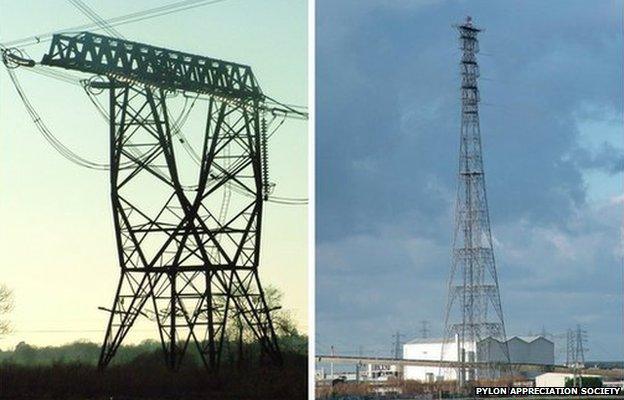
This pylon on the left is Flash's favourite while two pylons that span the Thames (right) are the UK's tallest
"It's also the fact that in terms of engineering, pylons are just decent solutions."
Among the 88,000 pylons dotted across the UK, Flash says her favourites are near Cressing Village in Essex, because they are "unusual in design and route cables on the left circuit under the right circuit into a substation".
But she also pays tribute to the tallest pylons in the UK, which span the River Thames at Thurrock - at 630ft (190m) high they are taller than London's BT Tower - and the Pink Pylon (officially named ZP226) near Rochdale in Greater Manchester.
Painted pink during filming for the 1998 pylon-based film Among Giants, it remained that way until it was taken down in 2003. It still has its own appreciation website, external.
'Bit geeky'
Flash's collection also features "weird Japanese pylons with nine or 12 arms", pylons in France that are painted the colour of their surroundings and "beautiful football goal-type pylons" in Iceland built to withstand ice storms.
Her ultimate goal is to see a transposition tower that regulates cables spanning hundreds of miles - which even she admits is "a bit geeky".
"It looks like this weird thing with arms going everywhere," she says. "Unfortunately the UK doesn't have them. I'd need to go to Africa to see one.
"Whenever I go on holiday, my poor long-suffering husband comes to power stations with me. Because that's where you find the most interesting pylons."
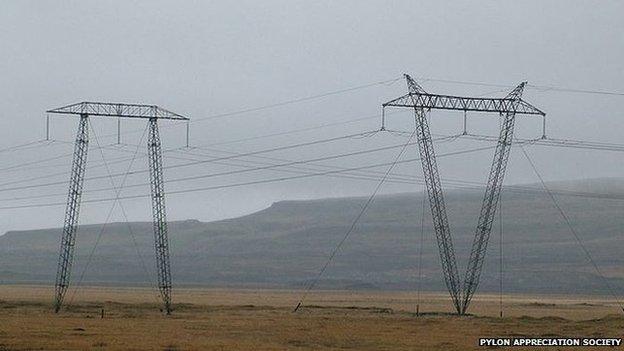
Examples of Icelandic pylons, designed to allow snow storms to blow through them
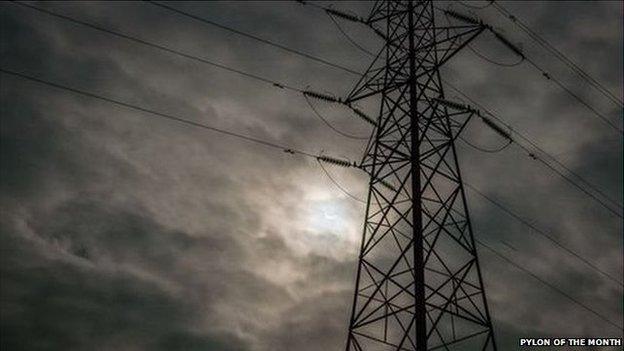
Last month's "Pylon of the Month" went to this structure near the Bridgewater canal in north west England
Strange as it might seem, Flash is by no means alone in her passion for pylons.
The society has over 600 members and boasts an active message board.
"They range from schoolchildren who are obsessed with pylons, right through to retired engineers who used to shin up pylons in the 70s," she says.
"They like the fact they can talk about technical details and be appreciated. Other people just post pictures and say 'this one looks pretty'."
Another aficionado is Kevin Mosedale, 47, a physics teacher from Oxfordshire.
He started the website Pylon of the Month, external as a joke but was astonished by the reaction.

A potted history of pylons

The first electricity pylon in the UK was built near Edinburgh in 1928. It was designed by leading architect Sir Reginald Blomfield.
Its "lattice" design sought to be more delicate than the brutalist structures used in Europe and the United States.
His design was inspired by the root of the word pylon - meaning an Egyptian gateway to the sun.
Over the next five years, more than 26,000 went up around the country - ahead of schedule and on budget. Although materials and the amount of electricity pylons carry has changed over the years, Blomfield's design has remained largely unchanged until now.
Source: National Grid

Kevin says: "There was a previous pylon of the month website that we used to look and laugh. Then one day it had gone and I thought it was bit sad, so I decided to start my own.
"I get pylon pictures from all over the world. It's really strange. There seems to be this strange fascination some people have with them. I don't know why.
"My students think it's quite funny. I've been pretty much been banned from talking about it by my wife.
"Probably because most people think, 'I can't believe you're sad enough to run a Pylon of the Month website'."
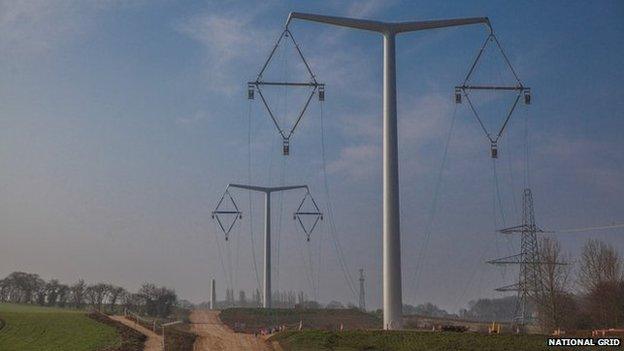
Flash Bristow thinks the new design looks like "a lamppost with Pat Butcher dangly earrings"
So what do these "pylonophiles" make of the new design?
"I think it's a cop-out - it looks like a lamppost with Pat Butcher dangly earrings," says Flash.
"If you're going to have something that big on the landscape, why not make it a sculpture?
"But they went for the safest, shortest option. What a wasted opportunity."
Kevin disagrees, however.
"I like them. They're a bit lower, and I think they blend in a bit better with the landscape, so I'm generally a big fan," he says.
"They might even feature as pylon of the month at some point."

A field guide to pylons
Electricity pylons, or transmission towers, are structures used to support overhead power lines
In the UK there are three common designs - the L2, L6 and L12
Most pylons stand at about 164ft (50m) high, weigh 30 tonnes and carry up to 400,000 volts of electricity
There are 88,000 pylons in the UK, including 22,000 belonging to the National Grid's high-voltage network
They carry 7,200km (4,470 miles) of overhead lines
If you stand under a high voltage pylon at night with a fluorescent tube, residual electric emissions will cause it to flicker and light up, as demonstrated by artist Richard Box who created a "field of lights" in 2004.
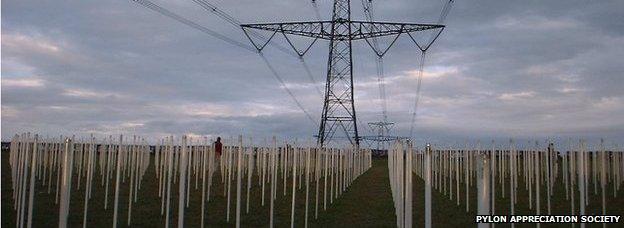
Source: National Grid, Pylon Appreciation Society

- Published10 April 2015

- Published23 May 2011
